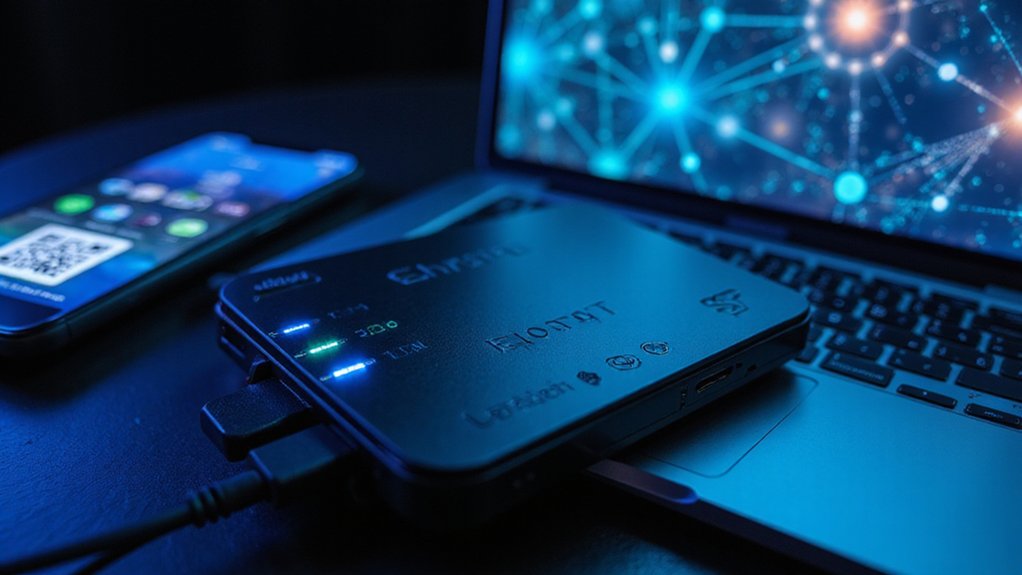A Web3 wallet serves as your digital identity vault in the blockchain ecosystem, storing private keys that authenticate ownership of digital assets. Unlike traditional payment systems, these applications leverage cryptographic principles to enable direct peer-to-peer transactions without intermediaries. Available in software (like MetaMask) and hardware variants, wallets facilitate interactions with smart contracts, decentralized applications, and governance systems across multiple networks. The distinction between custodial and non-custodial options determines whether you—or someone else—truly controls your financial sovereignty.

A Web3 wallet serves as the digital sentinel guarding the gateway to blockchain ecosystems, functioning far beyond the limited scope of conventional financial instruments.
At its core, this cryptographic toolset stores private keys—those strings of alphanumeric characters that authenticate a user’s identity on blockchain networks—while facilitating peer-to-peer transactions without traditional middlemen (who, one might note, have historically charged handsome fees for their often minimal exertions).
These technological marvels operate through public-private key cryptography, where the private key signs transactions and the public key generates wallet addresses visible on the blockchain. The evolution from centralized systems to blockchain-enabled wallets has fundamentally transformed how users control their digital assets.
The distinction between custodial and non-custodial variants proves critical; the latter empowers users with direct control over their private keys—a responsibility that carries both sovereignty and risk in equal measure.
Web3 wallets manifest in multiple incarnations: software wallets integrated into browsers or mobile devices; hardware wallets providing air-gapped security for the particularly cautious; and multi-signature implementations requiring approval from multiple parties—a prudent option for organizational treasury management. Users typically create a seed phrase consisting of 12-24 words that serves as a recovery mechanism should access to the wallet be compromised. Popular options like MetaMask offer both browser extensions and mobile applications that enable users to interact with dApps across multiple blockchain networks simultaneously.
Each offers varying degrees of convenience versus security, that eternal trade-off in digital asset management.
Beyond simple asset storage, these interfaces enable real-time interaction with smart contracts across multiple blockchains, allowing users to participate in decentralized finance protocols, manage non-fungible tokens, and engage in governance voting for decentralized autonomous organizations.
One might reasonably observe that such capabilities would have seemed like science fiction merely a decade ago.
Security mechanisms include seed phrases—those seemingly random collections of words that serve as the ultimate recovery mechanism—along with transaction previews and phishing detection to mitigate human error, still the predominant vulnerability in blockchain ecosystems.
Two-factor authentication provides an additional defense layer, particularly for hot wallets connected to the internet.
As interoperability advances, Web3 wallets increasingly function as universal passports to digital economies, streamlining cross-chain asset transfers and enabling seamless movement between decentralized applications.
This evolution represents the ongoing transformation toward truly user-sovereign financial systems.
Frequently Asked Questions
Are Web3 Wallets Vulnerable to Hacking?
Yes, Web3 wallets are indeed vulnerable to hacking.
Statistics reveal a sobering $2.3 billion lost to security incidents in 2024 alone, with phishing emerging as the predominant attack vector (surpassing even private key compromise).
Users face multiple threat vectors: phishing scams, private key vulnerabilities, smart contract exploits, software bugs, and—perhaps most troublingly—their own errors.
The financial stakes couldn’t be higher, with the average hack netting criminals a cool $3.1 million per incident.
Can I Recover My Wallet if I Lose My Seed Phrase?
Recovering a wallet without a seed phrase presents a sobering reality: it’s virtually impossible in most cases.
While certain platforms offer alternative recovery methods (identity verification, email access, etc.), these represent exceptions rather than rules.
The cryptographic architecture underpinning Web3 wallets—designed specifically to prevent unauthorized access—becomes the very barrier to recovery.
The industry’s mantra “not your keys, not your coins” transforms into the cautionary “no seed phrase, potentially no assets” when recovery becomes necessary.
Which Web3 Wallet Has the Lowest Transaction Fees?
Nano wallets offer the holy grail of transaction costs—absolutely zero fees—thanks to their distinctive block-lattice architecture that elegantly sidesteps the miner paradigm altogether.
For the fee-conscious who require broader ecosystem compatibility, Solana-based wallets deliver near-microscopic $0.00025 transaction costs, while TRON wallets cleverly provide one daily free transaction.
Smart wallets employing gasless relayers and Best Wallet’s token-based discount structure ($BEST) represent the vanguard of fee-minimization strategies in an otherwise expense-laden cryptosphere.
Do I Need Separate Wallets for Different Blockchains?
Not necessarily. While specialized blockchains occasionally demand dedicated wallets (Bitcoin maximalists might insist on Sparrow’s singular focus), modern Web3 wallets increasingly embrace interoperability.
Multi-chain solutions like Trust Wallet (supporting a staggering 160,000 assets) and Exodus (compatible with 50+ networks) eliminate the digital equivalent of bulging pockets.
Some users, however, deliberately maintain separate wallets—isolating high-value holdings from everyday transactions represents sound security hygiene rather than technological limitation.
Can Web3 Wallets Integrate With Traditional Banking Systems?
Web3 wallets can theoretically integrate with traditional banking systems, though the marriage remains awkwardly incomplete.
Several projects are bridging this gap through API interfaces and fiat on-ramps, allowing limited fund transfers between decentralized and conventional financial ecosystems.
The integration faces substantial hurdles—regulatory compliance, legacy infrastructure limitations, and security protocol incompatibilities chief among them.
Banking institutions (predictably cautious) are exploring controlled implementations while governments scramble to establish functional regulatory frameworks for these hybrid financial instruments.









